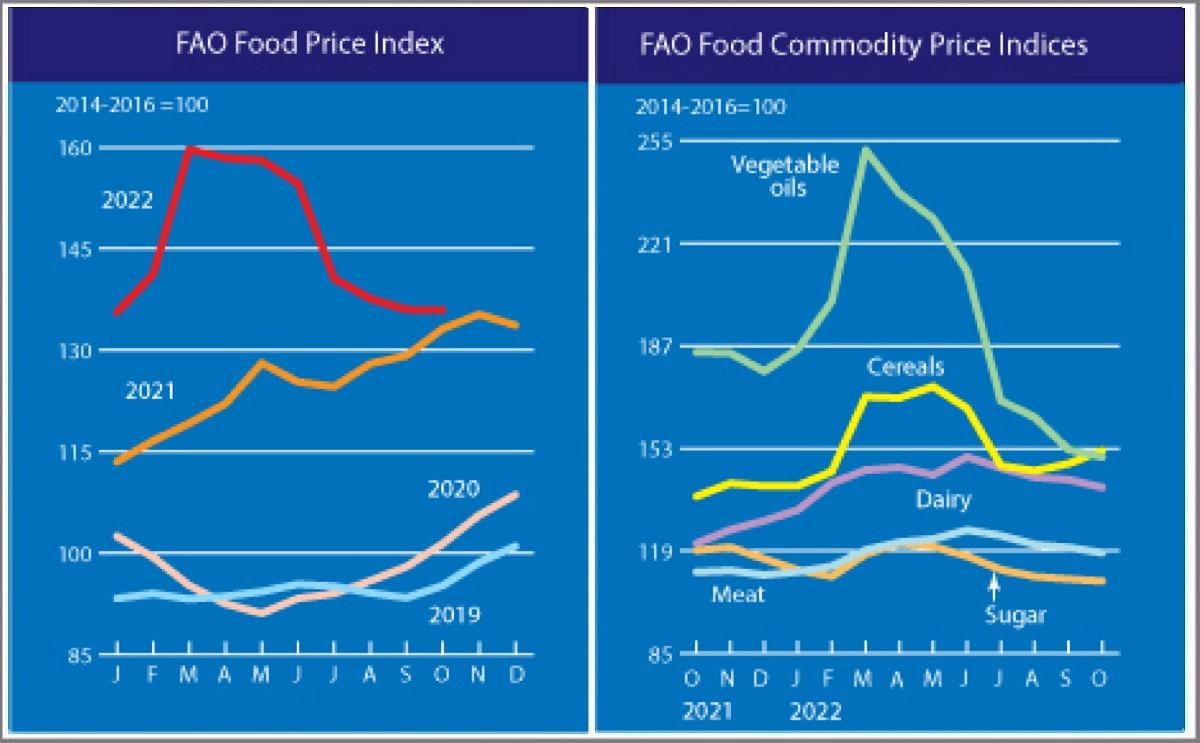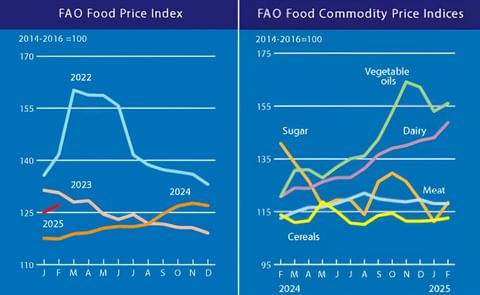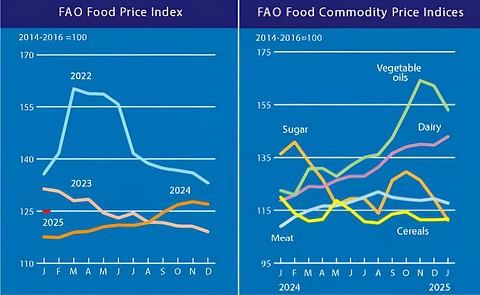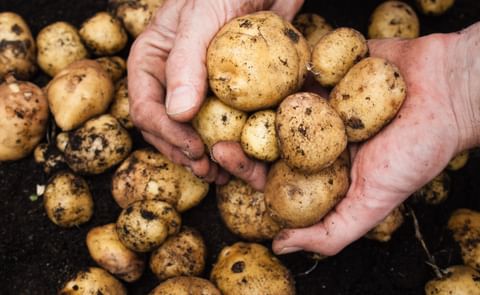FAO Food Price Index virtually unchanged in October

FAO Food Price Index virtually unchanged in October, with higher world cereal prices almost offsetting lower prices of other food commodities.
The FAO Food Price Index* (FFPI) averaged 135.9 points in October 2022, virtually unchanged from September, with the price indices of all the covered commodity groups, except cereals, down month-on-month.
An upturn in the Cereal Price Index countered drops in the indices for vegetable oils, dairy, meat and sugar. With the latest updates, the FFPI has dropped 23.8 points (14.9 percent) from its peak in March this year, but remained 2.7 points (2.0 percent) above its value in the corresponding month last year.
The FAO Cereal Price Index averaged 152.3 points in October, up 4.4 points (3.0 percent) from September and 15.2 points (11.1 percent) above its value a year ago. International reference prices of all the major cereals were up month-on-month.
World wheat prices rose by 3.2 percent, mostly reflecting continued uncertainties related to the Black Sea Grain Initiative. Tighter supplies in the United States of America, following a downward production revision, also contributed to the firmer tone in markets.
International prices of coarse grains increased by 3.5 percent month-on-month, led by a 4.3-percent rise in world maize prices.
The maize price increase was underpinned by lower production prospects in the United States of America and the European Union, along with dry planting conditions in Argentina and uncertainty about the continuation of Ukraine’s exports.
International sorghum prices also increased by 3.0 percent in October, influenced by the strength in maize prices. Meanwhile, world barley prices increased only marginally (0.3 percent), with higher global supplies stemming from better production prospects in the European Union helping to cap price gains.
International rice prices remained on an uptrend in October, as the bulk of new crop arrivals were still forthcoming in Asia, although low demand limited the monthly price increase to 1.0 percent.
The FAO Vegetable Oil Price Index averaged 150.1 points in October, down 2.4 points (1.6 percent) month-on-month and standing nearly 20 percent below its year-earlier level.
The continued decrease of the index was driven by world lower prices of palm, soy and rapeseed oils, which more than offset higher sunflowerseed oil quotations.
In October, international palm oil prices declined slightly from the previous month, broadly weighed by lingering heavy stock levels in Southeast Asia, despite concerns over unfavourable weather prospects in pockets of major growing regions.
Meanwhile, world soy and rapeseed oil quotations dropped on outlooks of ample supplies in the coming months.
By contrast, international sunflower oil prices rebounded moderately after falling continuously over the past half a year due to uncertainty over the future of the export corridor in Ukraine amid rising geopolitical tensions.
The FAO Dairy Price Index averaged 140.1 points in October, down 2.5 points (1.7 percent) from September, marking the fourth consecutive monthly decline, nevertheless, it remained 18.7 points (15.4 percent) above its value a year ago.
In October, international prices of all dairy products covered by the index fell.
Lower-than-anticipated purchases by China and lacklustre demand for spot supplies as most importing countries were well covered for their immediate needs, together with the impact of the weaker Euro against the United States dollar, underpinned the drop in world dairy prices.
Market uncertainty about the direction of demand for dairy products, due to soaring inflation and economic downturns, also pressured international dairy prices down.
Nonetheless, demand for some dairy products in other countries in Asia increased, containing potential larger declines in dairy prices.
The FAO Meat Price Index* averaged 118.4 points in October, down 1.6 points (1.4 percent) from September, marking the fourth consecutive monthly decline, with world prices of all meat types registering drops.
However, the index remained 6.4 points (5.8 percent) above its value a year ago. International ovine meat prices registered the steepest drop, underpinned by the impacts of currency movements and seasonally increasing supplies from Oceania amid subdued import purchases.
Likewise, world pig meat prices dropped substantially on weak global import purchases in tandem with softer internal demand in some leading producing countries. Meanwhile, world bovine prices fell slightly on high current supplies and rising availability of slaughter cattle, notably in Brazil.
International poultry meat price downward trend continued for the fourth consecutive month, as export availabilities outpaced subdued global demand, notwithstanding setbacks to production stemming from avian influenza outbreaks and high feed costs.
The FAO Sugar Price Index averaged 109 points in October, down 0.7 points (0.6 percent) from September and 10.1 points (8.5 percent) from its value in the corresponding month last year.
The positive global supply outlook for the 2022/23 season, further bolstered by improved production prospects in India, weighed on world sugar prices in October.
However, concerns over rains hampering harvest progress in Brazil and delaying the start of the season in India limited the month-on-month price decline.
Additional support that prevented world sugar prices from dropping further was lent by a stronger import demand, particularly from Indonesia and China, along with higher ethanol price quotations in Brazil, prompting a greater use of sugarcane to produce ethanol.
An upturn in the Cereal Price Index countered drops in the indices for vegetable oils, dairy, meat and sugar. With the latest updates, the FFPI has dropped 23.8 points (14.9 percent) from its peak in March this year, but remained 2.7 points (2.0 percent) above its value in the corresponding month last year.
The FAO Cereal Price Index averaged 152.3 points in October, up 4.4 points (3.0 percent) from September and 15.2 points (11.1 percent) above its value a year ago. International reference prices of all the major cereals were up month-on-month.
World wheat prices rose by 3.2 percent, mostly reflecting continued uncertainties related to the Black Sea Grain Initiative. Tighter supplies in the United States of America, following a downward production revision, also contributed to the firmer tone in markets.
International prices of coarse grains increased by 3.5 percent month-on-month, led by a 4.3-percent rise in world maize prices.
The maize price increase was underpinned by lower production prospects in the United States of America and the European Union, along with dry planting conditions in Argentina and uncertainty about the continuation of Ukraine’s exports.
International sorghum prices also increased by 3.0 percent in October, influenced by the strength in maize prices. Meanwhile, world barley prices increased only marginally (0.3 percent), with higher global supplies stemming from better production prospects in the European Union helping to cap price gains.
International rice prices remained on an uptrend in October, as the bulk of new crop arrivals were still forthcoming in Asia, although low demand limited the monthly price increase to 1.0 percent.
The FAO Vegetable Oil Price Index averaged 150.1 points in October, down 2.4 points (1.6 percent) month-on-month and standing nearly 20 percent below its year-earlier level.
The continued decrease of the index was driven by world lower prices of palm, soy and rapeseed oils, which more than offset higher sunflowerseed oil quotations.
In October, international palm oil prices declined slightly from the previous month, broadly weighed by lingering heavy stock levels in Southeast Asia, despite concerns over unfavourable weather prospects in pockets of major growing regions.
Meanwhile, world soy and rapeseed oil quotations dropped on outlooks of ample supplies in the coming months.
By contrast, international sunflower oil prices rebounded moderately after falling continuously over the past half a year due to uncertainty over the future of the export corridor in Ukraine amid rising geopolitical tensions.
The FAO Dairy Price Index averaged 140.1 points in October, down 2.5 points (1.7 percent) from September, marking the fourth consecutive monthly decline, nevertheless, it remained 18.7 points (15.4 percent) above its value a year ago.
In October, international prices of all dairy products covered by the index fell.
Lower-than-anticipated purchases by China and lacklustre demand for spot supplies as most importing countries were well covered for their immediate needs, together with the impact of the weaker Euro against the United States dollar, underpinned the drop in world dairy prices.
Market uncertainty about the direction of demand for dairy products, due to soaring inflation and economic downturns, also pressured international dairy prices down.
Nonetheless, demand for some dairy products in other countries in Asia increased, containing potential larger declines in dairy prices.
The FAO Meat Price Index* averaged 118.4 points in October, down 1.6 points (1.4 percent) from September, marking the fourth consecutive monthly decline, with world prices of all meat types registering drops.
However, the index remained 6.4 points (5.8 percent) above its value a year ago. International ovine meat prices registered the steepest drop, underpinned by the impacts of currency movements and seasonally increasing supplies from Oceania amid subdued import purchases.
Likewise, world pig meat prices dropped substantially on weak global import purchases in tandem with softer internal demand in some leading producing countries. Meanwhile, world bovine prices fell slightly on high current supplies and rising availability of slaughter cattle, notably in Brazil.
International poultry meat price downward trend continued for the fourth consecutive month, as export availabilities outpaced subdued global demand, notwithstanding setbacks to production stemming from avian influenza outbreaks and high feed costs.
The FAO Sugar Price Index averaged 109 points in October, down 0.7 points (0.6 percent) from September and 10.1 points (8.5 percent) from its value in the corresponding month last year.
The positive global supply outlook for the 2022/23 season, further bolstered by improved production prospects in India, weighed on world sugar prices in October.
However, concerns over rains hampering harvest progress in Brazil and delaying the start of the season in India limited the month-on-month price decline.
Additional support that prevented world sugar prices from dropping further was lent by a stronger import demand, particularly from Indonesia and China, along with higher ethanol price quotations in Brazil, prompting a greater use of sugarcane to produce ethanol.
*Unlike for other commodity groups, most prices utilized in the calculation of the FAO Meat Price Index are not available when the FAO Food Price Index is computed and published; therefore, the value of the Meat Price Index for the most recent months is derived from a mixture of projected and observed prices. This can, at times, require significant revisions in the final value of the FAO Meat Price Index which could in turn influence the value of the FAO Food Price Index.
Like to receive news like this by email? Join and Subscribe!
NEW! Join Our BlueSky Channel for regular updates!
精选企业
Sponsored Content
Sponsored Content
Sponsored Content
Sponsored Content
Sponsored Content









